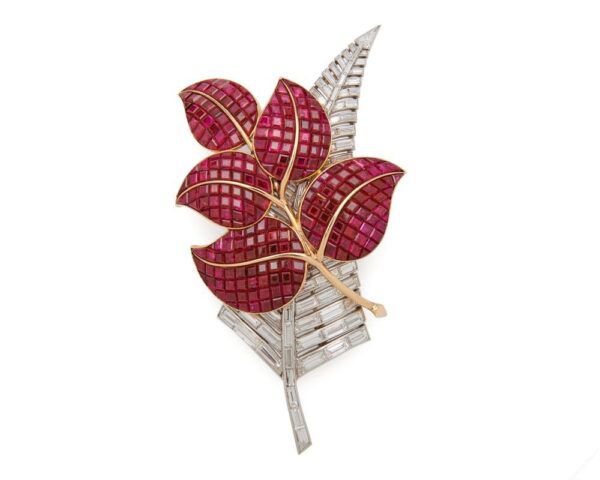#Mysteriously #Invisible #Stone #Settings #Van #Cleef #Trifari #WorthPoint
When thinking about jewelry bucket lists, running across a piece made with Trifari’s invisible stone settings ranks quite high for me. I’ve only seen a few of these pieces in person at costume jewelry collectors’ conventions, and I’ve never found one that came close to landing in my budget zone. These treasures remain eye candy that I study online and envision coming my way someday.
If you’ve never seen one of these pieces, that’s understandable. They’re considered rarities, so they’re usually priced in the thousands. Another thing that makes them special is that they were inspired by fine jewelry design. To learn about what the American brand Trifari was doing with these pieces during the 1930s and beyond, a look back at how one of the most famous French jewelry houses perfected the style is in order.
Van Cleef & Arpels Mystery Set Jewelry
Van Cleef & Arpels patented its superbly attractive Mystery Set jewelry in 1933. It wasn’t the only high jeweler making pieces with invisible stone settings at that point, but it did improve the process making its versions the best examples of this type of work. The firm’s innovation uses rails of gold to hold stones in place so all you see is a beautiful blanket of color from the front. Turn the piece over to reveal a grid of metalwork on the back.
Most of these stones are special hexagonal cuts that look square at first glance, but each one is sized appropriately for the intricacies of the jewelry design. Rubies have been used most often in Van Cleef & Arpels Mystery Set styles, although some pieces have sapphires, emeralds, or even diamonds within these complex and mesmerizing designs.
The Mystery Set differs from pavé settings in that small, round stones are set using tiny metal beads to hold them in place so that the entire surface is covered with gems. The word pavé in French refers to paved surfaces or cobblestones, and pavé set stones have that type of appearance in jewelry. While it takes skill to accomplish the technique of pavé setting stones, invisibly set stones are even more difficult.
Jewelers with the skill to make a Mystery Set piece of jewelry are few and far between. In fact, Van Cleef & Arpels notes that a clip set in this way takes an average of three hundred hours to produce. When looking at these pieces closely, there’s no doubt that the beautifully layered and sophisticated details could only be accomplished by a master like those employed by Van Cleef & Arpels.
While often associated with art deco jewelry, Mystery Set pieces have been produced quite often by Van Cleef & Arpels since then. In fact, in 2019, the legendary jewelry house introduced the Pomme de Pin clip incorporating navette-shaped (also known as marquis) stones to form pinecones. This is the first use of this shape to achieve a Mystery Set design, and the result is stunning. Another innovation is the Vitrail Mystery Set, where metal is invisible when viewed from both the front and the back.
Given the beauty of these pieces, it’s no wonder that a masterful costume jewelry company would be inspired to fill the need for similar designs made of more affordable materials.
Trifari’s Spellbinding Invisible Settings
If you’re familiar with Trifari jewelry at all, you probably recognize the name Alfred Philippe. He was the creative genius heading Trifari and was responsible for many of the firm’s most brilliant designs from the 1930s through most of the ‘60s. Before entering the costume jewelry industry, he worked for Cartier, so he was no stranger to high jewelry design and manufacture. With that knowledge, he was inspired to design invisibly set pieces of costume jewelry.
Philippe’s designs came at a time when fine jewelry demand had waned during the Great Depression, but many women still wanted the look of haughty adornment. Trifari did an excellent job of meeting this demand, although these pieces weren’t for everyone. Because the prices were relatively high for the period, a limited number were made and purchased by the fashionable ladies who could afford them then. In fact, Trifari continued to make jewelry with this look through the 1960s.
Rather than setting each stone invisibly in rows like fine jewelry, costume jewelry pieces achieving a similar look employ stones made of waffle glass. The glass segments are molded in one piece to look like a series of square stones and impart the illusion of invisibly set gemstones. The result is a swath of jewel-toned red, green, or deep blue hues that do a pretty good job of imitating the pieces produced by Van Cleef & Arpels.
If you’re lucky enough to find one of these pieces, take good care of it. When the waffle glass segments get damaged, they’re virtually impossible to replace. Store the pieces individually in boxes with tight-fitting lids to keep dust out of the stones. If you do need to clean one, brush it gently with a small, soft brush to get the dust out of all the nooks and crannies. If you’re even more fortunate to own a piece of Mystery Set fine jewelry, leave cleaning and care to a jeweler accustomed to dealing with high-end jewelry to avoid damage.
Like me, maybe you haven’t gotten that lucky yet. Fortunately, we can look at all the pieces that have sold in the WorthPoint® Price Guide and dream about finding one together.
Pamela Siegel is a freelance writer and author who has been educating collectors for more than two decades. In addition to three books on topics relating to antiques and collectibles, she frequently shares her expertise through online writing and articles for print-based publications. Pamela is also the co-founder of Costume Jewelry Collectors Int’l (CJCI) and the proprietor of Chic Antiques by Pamela.
WorthPoint—Discover. Value. Preserve.




